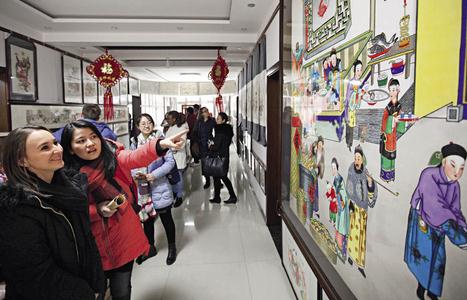Tianjin, thriving city of rivers
 0 Comment(s)
0 Comment(s) Print
Print E-mail China Today, October 13, 2016
E-mail China Today, October 13, 2016
Yangliuqing New Year Paintings
Tianjin, although a city nurtured by rivers, is generally regarded as having been born of the Grand Canal, to which its development owes a good deal. Running 190 km within Tianjin, the Grand Canal has left the city multitudinous tangible heritage, including the river course, locks, bridges, dykes, and other ancient remains. It is also site of ancient government offices, shops, towns, villages, streets, guildhalls, and posthouses that formerly flourished along the canal.
|
|
|
Students from Massachusetts Institute of Technology learn about the history and production process of Yangliuqing New Year woodblock paintings on January 14, 2016. |
Yangliuqing Town is a half-hour drive from Tianjin's downtown. More than 1,000 years of history have endowed it with a myriad of cultural traditions, and shaped its thriving businesses. The town is also a distribution center for North China's folk art works. Exceeding in popularity all of China's New Year woodblock print brands, Yangliuqing New Year paintings enjoy a high reputation. Yangliuqing-crafted kites, papercuts, carved stones and bricks are also in great demand. The town has consequently been awarded the title of "renowned town for inheriting charming Chinese culture."
Yangliuqing's two oldest New Year painting shops are those of Dai Lianzeng and Qi Jianlong, whose ancestors were probably also painters. Both came to Yangliuqing to ply their painting skills and avoid the ravages of war. The town's plentiful birch-leaf pear trees and date trees are eminently suitable for making the woodblocks used to produce New Year paintings. This is why New Year painting took root here. The Grand Canal also conveyed fine paper and watercolor pigments to Yangliuqing, so promoting development of local painting. By the Ming (1368-1644) and Qing (1644-1911) dynasties, the local painting industry had gained even greater momentum, and a fine reputation in North China. The mid-to-late Qing Dynasty saw the heyday of Yangliuqing's New Year painting industry. Back then, residents of both the town and nearby villages were generally solely engaged in producing New Year paintings, making Yangliuqing even more popular.
Featuring a vivid and lively style, abundant colors, and boisterous scenes, Yangliuqing New Year paintings cover a wide range of themes, in particular those reflecting real life, local traditions, and historical stories. One representative work is Liannian Youyu, which portrays a chubby little boy embracing a carp while holding a lotus, so implying lifelong abundance. Its auspicious meaning has made this painting a classic in the genre, and that most widely favored at Lunar New Year.






